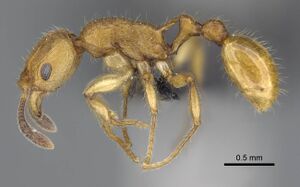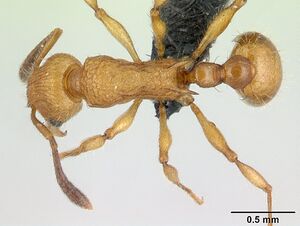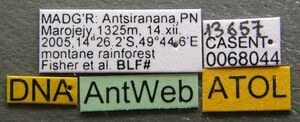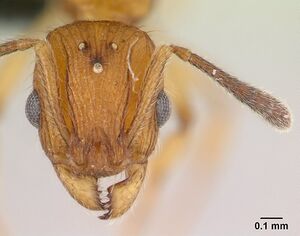Vitsika suspicax
| Vitsika suspicax | |
|---|---|

| |
| Scientific classification | |
| Kingdom: | Animalia |
| Phylum: | Arthropoda |
| Class: | Insecta |
| Order: | Hymenoptera |
| Family: | Formicidae |
| Subfamily: | Myrmicinae |
| Tribe: | Crematogastrini |
| Genus: | Vitsika |
| Species: | V. suspicax |
| Binomial name | |
| Vitsika suspicax Bolton & Fisher, 2014 | |
All material was retrieved from litter samples or from yellow pan traps, in montane rainforest.
Identification
Bolton and Fisher (2014) - Separated only weakly from Vitsika procera by the form and sculpture of the petiole node, which in suspicax is more slender and generally less angular in profile, with a broader and more shallowly convex dorsal margin in posterior view, and always more feebly and superficially sculptured. As mentioned under procera, it may transpire that suspicax and procera are respectively less and more strongly sculptured variants of a single species. A single worker from Ankarana (CASENT0275352), may represent a very closely related but separate species. This specimen is at the top end of the size range given above (HL 0.72, HW 0.60, SL 0.52, MfL 0.64), but has a higher and more slender petiole node than is usual, more strongly developed rugose sculpture on the mesosoma, and a metanotal groove that in profile is broader and more obviously concave. We consider this specimen as suspicax until more material indicates otherwise.
Keys including this Species
Distribution
Endemic to Madagascar.
Latitudinal Distribution Pattern
Latitudinal Range: -14.43527778° to -14.43527778°.
| North Temperate |
North Subtropical |
Tropical | South Subtropical |
South Temperate |
- Source: AntMaps
Distribution based on Regional Taxon Lists
Malagasy Region: Madagascar (type locality).
Distribution based on AntMaps
Distribution based on AntWeb specimens
Check data from AntWeb
Countries Occupied
| Number of countries occupied by this species based on AntWiki Regional Taxon Lists. In general, fewer countries occupied indicates a narrower range, while more countries indicates a more widespread species. |

|
Estimated Abundance
| Relative abundance based on number of AntMaps records per species (this species within the purple bar). Fewer records (to the left) indicates a less abundant/encountered species while more records (to the right) indicates more abundant/encountered species. |

|
Biology
Castes
Males have yet to be collected.
Worker
Images from AntWeb
   
| |
| Holotype of Vitsika suspicax. Worker. Specimen code casent0040798. Photographer Michele Esposito, uploaded by California Academy of Sciences. | Owned by CAS, San Francisco, CA, USA. |
   
| |
| Worker. Specimen code casent0068044. Photographer Erin Prado, uploaded by California Academy of Sciences. | Owned by CAS, San Francisco, CA, USA. |
Queen
Images from AntWeb
   
| |
| Queen (ergatoid). Specimen code casent0914211. Photographer Michele Esposito, uploaded by California Academy of Sciences. | Owned by CAS, San Francisco, CA, USA. |
   
| |
| Paratype of Vitsika suspicax. Queen (alate/dealate). Specimen code casent0040783. Photographer Erin Prado, uploaded by California Academy of Sciences. | Owned by CAS, San Francisco, CA, USA. |
   
| |
| Paratype of Vitsika suspicax. Queen (alate/dealate). Specimen code casent0040796. Photographer Erin Prado, uploaded by California Academy of Sciences. | Owned by CAS, San Francisco, CA, USA. |
   
| |
| Queen (ergatoid). Specimen code casent0914196. Photographer Michele Esposito, uploaded by California Academy of Sciences. | Owned by CAS, San Francisco, CA, USA. |
Nomenclature
The following information is derived from Barry Bolton's Online Catalogue of the Ants of the World.
- suspicax. Vitsika suspicax Bolton & Fisher, 2014: 91, figs. 114-116, Map 160 (w.q.) MADAGASCAR.
Unless otherwise noted the text for the remainder of this section is reported from the publication that includes the original description.
Description
Worker
(holotype in parentheses). TL 3.0–3.4 (3.3), HL 0.66–0.72 (0.72), HW 0.53–0.60 (0.56), CI 79–83 (79), SL 0.46–0.52 (0.47), SI 82–89 (84), PW 0.41–0.48 (0.44), WL 0.84–0.94 (0.90) (12 measured).
Eye with 7–8 rows of ommatidia, and with 9–10 ommatidia in the longest row; EL 0.16–0.19 (EL/HW 0.29–0.32). MfL 0.54–0.64 (MfL/HW 0.98–1.08). Diameter of annulus of propodeal spiracle equal to or greater than the thickness of the propodeal spine at its midlength. Petiole node in profile more or less erect with respect to the peduncle, the node not obviously inclined posteriorly; node usually without a defined posterior surface that is distinctly differentiated from the dorsum. In general the ascending anterior face of the node terminates in a blunted anterodorsal angle, which is the highest point of the node. Behind this the dorsum slopes downward posteriorly and rounds broadly and evenly into the sloping posterior face. In some specimens the two surfaces meet through a more obvious rounded angle. Sculpture of petiole node faint to vestigial: in some specimens the node with faint superficial microsculpture only; in others a few extremely weak and fine striae ascend the anterior surface, but when these occur they never traverse the sides near the dorsum, nor overlap onto the posterior surface. Height of petiole node in posterior view (from midpoint of the dorsal margin of the foramen to the apex) 0.87–0.96 × its maximum width. In dorsal view postpetiole 1.08–1.20 × broader than long; maximum width of postpetiole < 1.20 × the length of a propodeal spine; maximum width of postpetiole 0.93–1.00 × the distance between the apices of the propodeal spines. Length of postpetiole node in profile about equal to the height of the segment. Dorsum of postpetiole usually entirely smooth on the disc; weak punctulate sculpture is usually present posteriorly and laterodorsally, and weak laterodorsal longitudinal costulae are sometimes present. Full adult colour yellow.
Queen
(gyne). May be ergatoid, alate, or intermediate between the two (e.g.CASENT0914196). Two extreme ergatoid specimens are known; one lacks ocelli and the other has a small median ocellus present. In both, the mesonotum is somewhat more swollen than in the worker, and the mesopleuron lacks a transverse sulcus. Both are about equal in size to the largest specimen currently regarded as a worker, HL 0.73–0.74, HW 0.58–0.59, CI 78–81, SL 0.52–0.53, SI 90, PW 0.45–0.46, WL 0.96, MfL 0.62 (2 measured). Two intermediate specimens (one with gaster missing) are known; both have three distinct ocelli, and a distinct transverse sulcus on the mesopleuron. The mesosoma is almost worker-like but is larger and has weakly differentiated flight sclerites, a fused mesoscutum plus mesoscutellum instead of a simple mesonotum, and the metanotum is vestigially present. In dorsal view the pronotum is fused to the mesoscutum, separated from it only by an impression, there is no suture, and the reduced mesoscutum and mesoscutellum are fused; there are no traces of wings. Dimensions of the intermediate forms fall broadly within the worker range: HL 0.69–0.70, HW 0.58, CI 83–84, SL 0.47–0.48, SI 81–83, PW 0.44–0.54, WL 0.88, MfL 0.57–0.58 (1 measured). Four dealate queens are known, three of which are included in the type-series. These possess a swollen mesosoma with a full complement of flight sclerites, have 3 distinct ocelli, and have a conspicuous transverse sulcus on the mesopleuron. Cephalic dimensions of these specimens are only slightly larger than in the workers, but the mesosoma is more voluminous: HL 0.73–0.75, HW 0.60–0.61, CI 81–84, SL 0.52–0.53, SI 85–87, PW 0.53–0.56, WL 1.02–1.10, maximum width of mesoscutum 0.48–0.52, maximum length of mesoscutum 0.55–0.56, MfL 0.65–0.67 (3 measured).
Type Material
Holotype worker, Madagascar: Prov. Antsiranana, P.N. Marojejy, 25.7 km. 32° NNE Andapa, 21–23.xi.2003, 1575 m., 14°26.7’S, 49°44.5’E, sifted litter, montane rainforest, BLF 9242(L0), CASENT0040798 (Fisher et al.) (California Academy of Sciences). Paratypes. 2 workers and 3 dealate queens, with same data as holotype: workers, BLF 9242(4), CASENT0040785; BLF 9242(9), CASENT0040788; queens, BLF 9242(L0), CASENT0040796; BLF 9242(2), CASENT0040783; BLF 9242(21), CASENT0040794 (CASC).
References
- Bolton, B. & Fisher, B.L. 2014. The Madagascan endemic myrmicine ants related to Eutetramorium (Hymenoptera: Formicidae): taxonomy of the genera Eutetramorium Emery, Malagidris nom. n., Myrmisaraka gen. n., Royidris gen. n., and Vitsika gen. n. Zootaxa 3791:1–99. doi:10.11646/zootaxa.3791.1.1

